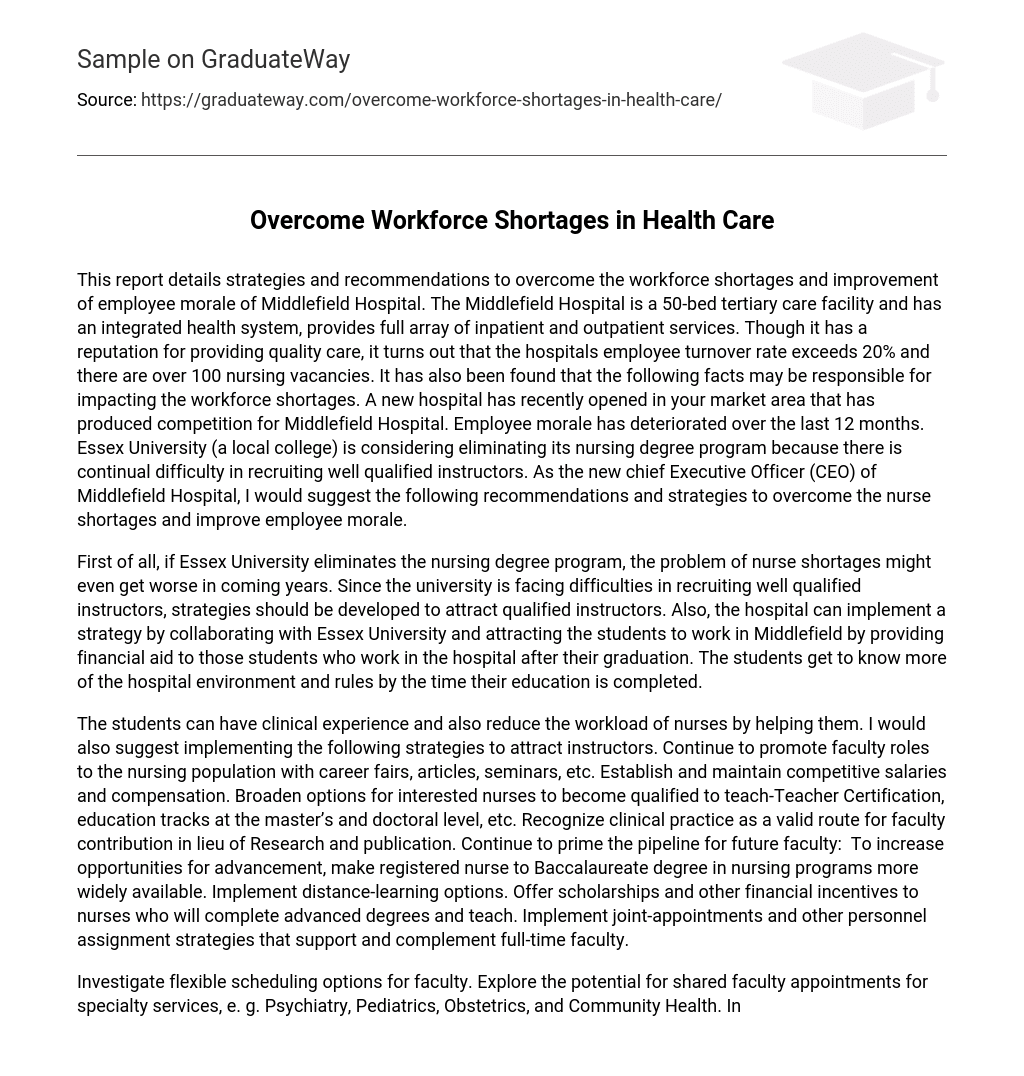The purpose of this report is to provide strategies and recommendations for resolving workforce shortages and boosting employee morale at Middlefield Hospital. Despite its reputation for delivering high-quality care, the hospital currently faces a turnover rate exceeding 20% and more than 100 vacant nursing positions. The workforce shortages are due to multiple factors, such as the emergence of a new local hospital, declining employee morale over the past year, and potential difficulties in recruiting qualified instructors if the nursing degree program at Essex University gets eliminated. As the newly appointed CEO of Middlefield Hospital, I propose implementing the following recommendations and strategies to address nurse shortages and improve employee morale.
Eliminating the nursing degree program at Essex University could exacerbate the issue of nurse shortages. The university is struggling to recruit highly qualified instructors, so it is necessary to devise strategies to attract them. Moreover, the hospital can partner with Essex University to entice students to work in Middlefield. Financial assistance can be offered to students who commit to working at the hospital after graduation. This approach allows students to familiarize themselves with the hospital environment and regulations during their education.
The students can gain clinical experience while also relieving nurses of some of their workload. To attract instructors, it is suggested to promote faculty roles through career fairs, articles, seminars, etc. Additionally, competitive salaries and compensation should be established and maintained. Interested nurses should have more options to become qualified to teach, such as obtaining Teacher Certification or pursuing education tracks at the master’s and doctoral level. It is important to acknowledge clinical practice as a valuable contribution for faculty, in addition to research and publication. To prepare future faculty members, registered nurse to Baccalaureate degree nursing programs should be made more widely available, and distance-learning options could be implemented. Offering scholarships and other financial incentives to nurses who complete advanced degrees and teach would also be beneficial. Joint-appointments and other personnel assignment strategies that support full-time faculty should be implemented.
Investigate flexible scheduling options for faculty and explore the potential for shared faculty appointments in specialty services such as Psychiatry, Pediatrics, Obstetrics, and Community Health. Also, increase state funding for nursing programs to reflect market compensation trends and accommodate the growing number of program enrollments. Additionally, fully fund the Health Personnel Shortage Incentive Grant Program.
One way to reduce turnover among graduates of the RN Residency program is by allowing them to explore different units within the hospital instead of leaving the profession. To ensure that nurses have regular breaks, additional nurses are scheduled for three-to-four-hour shifts specifically for lunch breaks. If a unit is understaffed, nurses may have the opportunity to work extra hours.
To decrease workload and create a less hectic environment for nurses, one solution could be hiring nursing students from local colleges like Essex University. These students can assist with tasks such as dressings and wound care.
In order to improve workplace conditions and increase job satisfaction, it is important for the hospital to implement various strategies. This includes enhancing patient satisfaction levels, offering convenient locations for staff, providing transportation facilities during odd hours, and ensuring an adequate number of Patient Care assistants (PCAs) to help alleviate workloads.
Flexible staffing, flexible scheduling, and self-scheduling options are provided for nurses who are pregnant or have young children. The hospital also offers tuition reimbursement, communication activities, and flexible career assignments and professional development opportunities. It is recommended that nurse leaders regularly visit the hospital to address any issues and concerns. Staff recognition events should be organized on a regular basis. In order to understand why employee morale is declining, meetings should be conducted with the staff to gather their opinions and appropriate measures should be taken accordingly. Additionally, the hospital should invest in improving technology and facilities to prevent physicians and other staff members from leaving for another hospital. Plans should also be made to redesign the hospital in alignment with the changing healthcare system and to make use of funding provided by state and federal governments.





